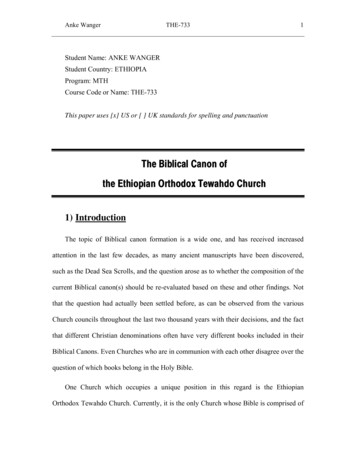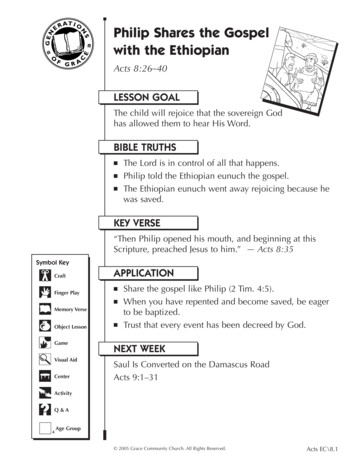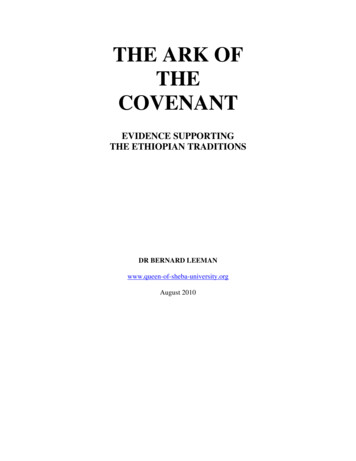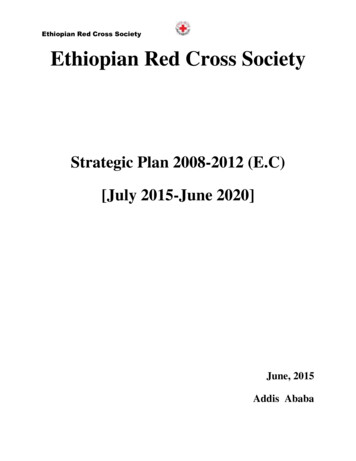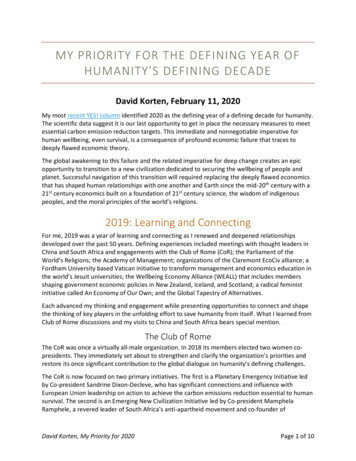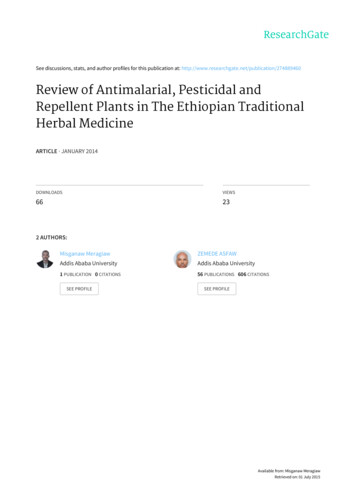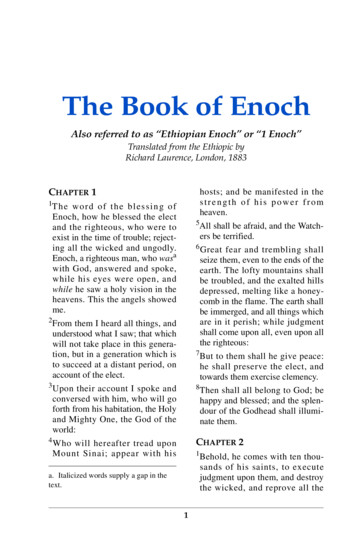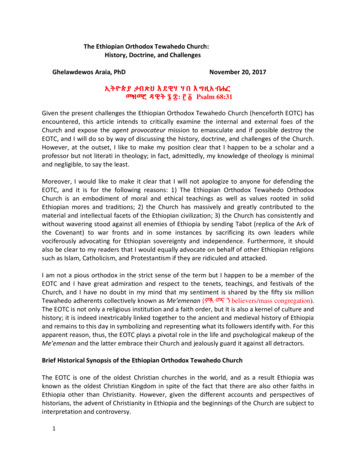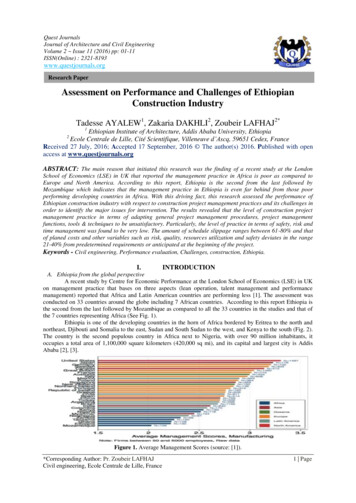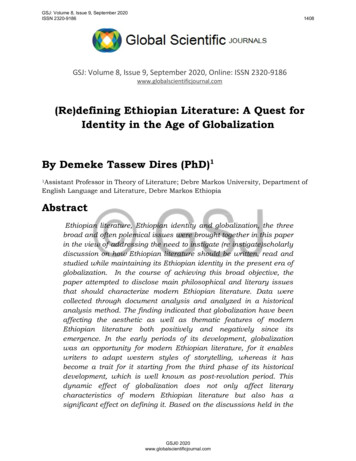
Transcription
GSJ: Volume 8, Issue 9, September 2020ISSN 2320-91861408GSJ: Volume 8, Issue 9, September 2020, Online: ISSN ng Ethiopian Literature: A Quest forIdentity in the Age of GlobalizationBy Demeke Tassew Dires (PhD)11AssistantProfessor in Theory of Literature; Debre Markos University, Department ofEnglish Language and Literature, Debre Markos EthiopiaAbstractEthiopian literature, Ethiopian identity and globalization, the threebroad and often polemical issues were brought together in this paperin the view of addressing the need to instigate (re instigate)scholarlydiscussion on how Ethiopian literature should be written, read andstudied while maintaining its Ethiopian identity in the present era ofglobalization. In the course of achieving this broad objective, thepaper attempted to disclose main philosophical and literary issuesthat should characterize modern Ethiopian literature. Data werecollected through document analysis and analyzed in a historicalanalysis method. The finding indicated that globalization have beenaffecting the aesthetic as well as thematic features of modernEthiopian literature both positively and negatively since itsemergence. In the early periods of its development, globalizationwas an opportunity for modern Ethiopian literature, for it enableswriters to adapt western styles of storytelling, whereas it hasbecome a trait for it starting from the third phase of its historicaldevelopment, which is well known as post-revolution period. Thisdynamic effect of globalization does not only affect literarycharacteristics of modern Ethiopian literature but also has asignificant effect on defining it. Based on the discussions held in theGSJ 2020www.globalscientificjournal.com
GSJ: Volume 8, Issue 9, September 2020ISSN 2320-91861409analysis, this study, therefore, attempts to concluded by vigilantlyforwarding the possible Ethiopian definition for Ethiopian literature.Key Words: Globalization; Ethiopian Literature; Identity.1. IntroductionOnce up on my lecture days, in a senior class where I was assigned to teach acourse named ‘Theory of literature and criticism’, I asked my students a trivialquestion on purpose. I wrote the title of two well-read Ethiopian novels on thewhite board i.e., ‘Fiker Eskemekaber’ (love unto Grave)(1959) written by thewell known Ethiopian writer Haddis Alemayehu and ‘Tekusat’ (fever)(2000) ,the ‘as is’ (Endeworede) version, a rather erotic novel written by anotherprominent Ethiopian writer Sebehat Gebre Egziabher, and I asked them whichone is their favorite novel. Most of them indicated the later as their favorite one.I asked them why? With almost similar tone they replied, “It reflects ourfeeling.” I continued asking, “What is your feeling? And how is it reflected inthe novel?” They answered my question with laughter. Though I understoodwhat this laughter means in relation to the content of their favorite novel, I toldthem, with intentional objection, that they were wrong because, I said “Thisnovel is not Ethiopian as the other one is.” Following my remark, I was almostbooed off the class by the students. However, after I calmed them down I gavethem a chance to reflect their opinion on the issue I raised. Following mycomment, a student raised his hand and asked me, “What is Ethiopianliterature?”What is Ethiopian literature? Did I give him the correct answer? I do not thinkso because I do not know what makes a literature Ethiopian in a strict sense.Incidentally, is there any definition for Ethiopian literature? What are theEthiopian elements I was referring to when I said Love unto grave is typicallyEthiopian? What makes students to praise Fever than the other novel? Allthese questions motivated me to write this paper in the view of instigating (orre-instigating) scholarly discussion on Ethiopianizing modern Ethiopianliterature (Ethiopian modern literature?), here after referred to as Ethiopianliterature, in the present era of globalization.2. Modern Ethiopian Literature: Its history in briefIt is astonishing to learn that modern Ethiopian literature has a century oldhistory which started following the publication of a novel entitled Lebb WalladGSJ 2020www.globalscientificjournal.com
GSJ: Volume 8, Issue 9, September 2020ISSN 2320-91861410Tärik by Afawarq Gabrayasus in 1908 E.C. (Gerard 1971; Mengistu 1973; Taye & Shiferaw2000; Wright 1963; Yonas 1995). This pioneer novel introduced a new genre ofliterature to Ethiopia that had been characterized by its age old heritage ofpious literature. Before Lebb Wallad Tärik fictional writing in the vernacular was notknown except poetry. Writing poetry in Amharic in a modern sense is started by a man called Gebre Egziaberfrom Tigray (1860-1940) (Gerard,1971 )).It is because of this novel that Ethiopia was introduced with a new form of storytelling called,'Lebb Wollad' in Amharic as an equivalent word for the English ‘Fiction’. To see how this formof storytelling develops throughout its history, let us see it in relation to periodical categories thatI borrow from scholars who write on Ethiopian literature such as Gerrard (1971),.2.1.The Pre-war periodThis period refers to the period before the second Italian invasion to Ethiopia (before 1935) .Literary, this period is characterized by the emergence of pioneer works in different creativewritings namely, poetry, novel and drama. As indicated above, poetry in its modern form andnovel writing was started in this period. Similarly, modern drama, a genre which was almostunknown for Ethiopians before that time was brought to existence in the country in this period.In this regard a playwright called Girmachew Teklehawaryat, with his pioneer allegorical dramaYe Awurewoch Comedy (Comedy of Animals) take the credit.This period can be referred to as a difficult period for Ethiopians to accustom themselves withforeign ways of storytelling. Because the educational and social background of most of thewriters was from traditional church schools where historical and religious writings, grammar andkenne (poem) were well known genres, disengaging themselves from the tradition they had beenthrough at once could have been difficult. It seems because of this that Ethiopia had to wait forabout seven years to read its second novel which was written by Heruy Woldesselsie under thetitle Wodge Lebie (My friend my heart) in 1915 E.C. After the emergence of this second novel,Ehiopian literature started to develop with a considerable pace. Heruy added two fictional worksalmost within ten years and along with fictional writings both Heruy and Afework were busyproducing non-fictions. A number of plays were written by Ethiopians such as Sahle Tsadalu andYoftahie Nigusie. Motivated by the approach of Italian war in 1935, several poems of patrioticnature were written. Writers like Walde Giorgies Wolde Yohaness come to the front in thisregard.Generally, this period, was a period in which the foundation of Ethiopian literature was laiddown, and without any exaggeration, it was a period in which literary works that are still beingread and studied were produced. Though its promising advancement was interrupted by Itallianinvasion, Ethiopian literature at this period was able to gain its individuality. This individualitywas maintained through different characteristics. Faithfulness is the first one. Literature in thisperiod was characterized by its faithfulness to the nation's social, cultural and religious valuesGSJ 2020www.globalscientificjournal.com
GSJ: Volume 8, Issue 9, September 2020ISSN 2320-91861411such as language, religion and the Throne. Most of the writers in this period were able to speakand write in western tongues, as they used to live in different countries for educational and/orgovernmental tasks. However, when they write stories in the western style, they didn't attempt tochange the medium. They rather preferred to stick to their mother tongue. In addition to languagethey were also indebted to their religion and the Throne. They were not against religious valuesof the nation nor were they skeptical to the political system of that period, i.e., the monarchicalsystem.However, writers in this period were change seekers, which can be taken as the secondcharacteristics of literature in this period. Through their works they preached the need to makechange in some socio-cultural aspects of the nation. For instance, they criticized detrimental(harmful ) social acts such as corruption, early marriage and women's rights.In addition to the aforementioned characteristics, literature in this period was also characterizedby thematic solemnity, which mainly focuses on National unity, patriotism and bravery andbeing Didactic, most of the works focus on moral and secular teachings2.2. The Post-war periodDespite the fact that the second Italian invasion interrupted Ethiopians from producing theirliterary works , it was not able to stop their creativity. Because of this, soon after the victory,poems that celebrate the victory and the return of the king to his throne were collected fromindividuals and published as an anthology under the title Yaddis Zemen Mezmur (Hymens tothe new era) . This anthology, then, begins the second period of Ethiopian literature that is oftenreferred to as" the golden age of Ethiopian literature". It was indeed the golden age becausemost of the writers that gave us our masterpieces were generations of this period. KebedeMikael and Tsegaye Gebremedhen in modern poetry, Tekle Hawaryat Tekle Mariam, TsegayeGebremedhen, Mengistu Lemma in drama, Mekonen Endalkachew, Germachew Teklehawaryat,Haddis Alemayehu, Brihanu Zerihun, Abe Gubegna, Beka Nemo, in novel; Taddesse Liben inshort story, are few of them.These writers can be categorized in to two groups: writers from older generation and writersfrom Younger generation. Prolific writers such as Mekonen Endalkachew, GermachewTeklehawaryat and Kebede Mikael are included under the first category and the rest of thewriters stated above are considered as from the younger generation. The appearance of thesewriters from two generations did not create any incongruity rather it created a great opportunityto transfer Ethiopian literary tradition that the old generation started at the early periods ofEthiopian literary history to the new generation.Because of this, most of the thematic and artistic traditions observed in the previous periodpersist in this period. Of course, the new generation that comprises personalities whosebackground is from traditional church schools and who have exposure for the outside world justGSJ 2020www.globalscientificjournal.com
GSJ: Volume 8, Issue 9, September 2020ISSN 2320-91861412like the old generation, made their own artistic standard through those classic works we are stillenjoying.In this period, in addition to writing original artistically elevated creative writings, translatingEuropean fictional works was also actively performed. A number of novels, plays and poemswere translated mainly from English language to Amharic. In this regard, Kebede Mikael’s effortto translate Shakespeare’s works such as Romeo and Juliet, owns a significant place. We havethe Amharic version of “to be or not to be ” because of his translation.Un disputably, in this period of Ethiopian literature, development in artistic quality is observed.Most of the creative works have comparatively elevated standard in artistry. However, they werenot by any means different from their predecessors in relation to their content and purpose. Aspre war period literary works, works of this period were characterized as didactic nature.Faithfulness and social criticism were dominantly seen in the works of these periods. However,around the last years of the monarchical system, a number of revolutionary literary works werepublished. ‘Alewoledm’ (1970) written by Abe Gubegna can be taken as a good example for this.The Post-revolution periodThis period marks a new history of Ethiopia. The monarchical system that had been on power forcenturies was changed to communist military system. Marxist, Leninist thinking dominates elitegroup. Writers with this socialist mentality came to the scene. In this period the dominant literaryfeature observed is socialist realism in which writers attempted to present the social, political andeconomic miseries of the society that were imposed on Ethiopians because of the buorzua. As aresult, a kind of discontinuity is observed in the literary tradition of the country.Although most of them were still writing in the vernacular, and were faithful for it, unlike writersin the previous periods, they were more faithful for Marxist Lenninist thoughts than religion,tradition and social norms. Most of the writers considered these values that their predecessorswere keenly preserving as manifestations of backwardness. They rather preached socialism, andrevolution. They were rather propagandists. They want literature to serve politics. Because ofthis Maladjustment became the dominant thematic preoccupation of these literary works.One thing that deserve mentioning at this point is the interruption of literary traditions that theearlier writers tried to establish for years. As we saw in the above section, earlier Ethiopianwriters were concerned in Ethiopian way of expressing social issues. When they were criticizingfor instance, they did it through advice and/or suggestion . Whereas, disgrace, insult andmortification on social customs and traditions were features of literary works in this period. Itseems why the dominant thematic preoccupation of most of the literary works in this period ismaladjustment, disparity between socialism and tradition etc.GSJ 2020www.globalscientificjournal.com
GSJ: Volume 8, Issue 9, September 2020ISSN 2320-91861413Generally, in this period we have seen literary works mostly of revolutionary in their orientationand Marxist in their literary form and content. Of course artistic advancement was observed insome literary works such as Bealu Girma’s Kadmas Bashager (Beyond the horizon).The present periodThe period we are living now is different from the previous periods in so many ways. Thecountries political and economic systems differ from those used throughout its long history. Mostof these systems are new and are the source of both hope, on the one hand, but also of despair inthe country, on the other hand. In his recent Amharic novel Rämätohärä (2010: 113), YesmaekeWorku prefers to adapt Charles Dickens’s (1859) words to explain present-day Ethiopia. Heasserts that in present-day Ethiopia, it “ is the best of times, is the worst of times, it is the ageof wisdom, it is the age of foolishness, it is the epoch of incredulity, it is the season of light, it isthe season of darkness .” This writer’s uncertainty regarding the essence of present-dayEthiopia seems the result of a number of contradictions in the political, economic and sociocultural practices of the country. Politically, it is practicing a so-called “democratic” system;nonetheless, many local and foreign bodies often condemn it for being “undemocratic.”Economically, the government boasts a 10-12% economic development figure each year, thoughthe country is still one of the poorest in the world. Culturally, though there has been culturaldevelopment in some areas (for instance, in developing the culture of ethnic groups), informationtechnology, popular western literary works and the film industry, for example, are westernizingthe country more than ever before. In general, this period is one full of contradicting phenomena.The Literature also suffers from this trauma. We cannot determine the peculiar characteristicsand nature of Ethiopian literature at this time because of different reasons. One of these reasonsis the irreconcilable differences amongst writers. Most of the prominent writers whose works canbe referred to here as exemplars are the ones who had been the member of revolutionists in theprevious period. Most of the creative works of these writers that are published at this time arethe ones that did not see the light of publication in the previous period because of censorship andother socio-political reasons ( We can take Sibehat Gebre Egziabher’s novels as an examplehere). Because of this, we can hardly take them as the products of the present period. Certainly,their influence on the youngest group of amateur writers who neither attend traditional churchschools nor has an exposure to the external world as their elders, is not significant. Consequently,the new ‘Democratic’ generation starts writing creative works ‘democratically’.GSJ 2020www.globalscientificjournal.com
GSJ: Volume 8, Issue 9, September 2020ISSN 2320-91861414Because the tread of Ethiopian way of creative writing was detached from Ethiopian writerssince the third period, especially after the middle of that period where Marxist revolutionarywriters dominate the floor of Ethiopian literature, these youngsters do not have a chance to knowabout that tradition. Without any exaggeration, most of the so called writers are book warmersnot book worms. The do not read the literary works written by their elders. If they do with anychance they tend to criticize them for not being as trailer as Aghatha kriestie’s, Erving Wales’sor Sydney Sheldon’s novels because these and so many others of similar quality are what theyknow very well as a consequence of translations (at the middle of this period before six or sevenyears, almost all novels published in Ethiopia were translations of such kind of popular works).The cinema, internet and English premier league effects are additional factors that worsen thesituation. Hence, how is Ethiopian literature at present characterized? We can identify thefollowing as observable characteristics:-Detachment:- they are detached from the Ethiopian tradition of story telling-Reluctance:- most of them are reluctant for their tradition, culture and social value-Eroticism:- It seems that not to write taboo becomes a taboo itself-Destructiveness:- destructing history, social set up,-Unfaithfulness:- for religion, language,-Egocentricity:- the authors write what they want to write not what others need to know-Europeanism:- art for art’s sake is pronounced by most of themGenerally, Ethiopian literature in this period signifies the climax of its down ward development.However, especially after the past five years, it seems that the resurgence of Ethiopian literatureis approaching. We start to see works with Ethiopian test such as a novel called Dertogadawritten by Yesmake Wokru, though they also suffer a lot from the detachment.2.Ethiopian literature and globalizationApart from the debates that recur around it, I, intuitively, accept globalization as “ a processfuelled by, and resulting in, increasing cross- border flows of goods, services,money, people, information, and culture” (Held et al 1999, p. 16). In thisdefinition one thing is made clear, cross-border flows of culture. Sinceliterature is one part of culture and also a means through which culture isexpressed, accepting this definition may not make our subject of discussion farGSJ 2020www.globalscientificjournal.com
GSJ: Volume 8, Issue 9, September 2020ISSN 2320-91861415from our working definition. According to the given definition, in globalizationthere is one important aspect that needs a mention here "cross-border flow ofculture" that signifies the possibility of accepting others culture and givingonce culture to others. In this case, globalization can be considered as anopportunity. However, in relation to Ethiopian literature it has been both anopportunity and threat.3.1. Globalization as an opportunityAs discussed in the above sections, the new form of storytelling was broughtto Ethiopia by personalities who had been overseas for political andeducational responsibilities. Afework Gebreyessus, for instance, had been inItaly for so many ears and even married to an Italian. What these people readin European countries fascinated and motivated them to try to narrateEthiopian stories in the same manner. While doing this they only accept theform with cautious adaption to Ethiopian historical, cultural and socialcontext. That is why the typical Ethiopian qualities of Ethiopian literature thatwe identified above in the first and second periods of its history were observed.In this case writers in this period were using globalization as an opportunity toadvance the tradition of storytelling of the country not to change it.It is important to emphasize here that the writers of the two periodsaforementioned were not fostering to change the age-old tradition of Ethiopianstory telling that was characterized by religiousness. They rather attempted toadvance it in its purpose, content and form. Globalization helped them tosecularize, to socialize and modernize their literature without changing itsidentity.3.2. Globalization as a threatGlobalization started to be a threat for Ethiopian literature starting from itsthird historical period. As indicated above, post revolution creative works wereunder a great influence of Russian literature. Most writers, especially themembers of the young group, had an exposure to socialist countries like Russiaand Cuba. The rest who did not have chance to go to these countries , werealso under the influence of these socialist literary works because they wereexposed to a number of Russian literary, political and even economic booksthat had been translated to Amharic. Being influenced by them would havebeen easier if they had not accepted socialist literary works as archetypes ofliterary standard. Hence, being added to their revolutionary thinking, mostwriters in this period wrote Amharic Russian literary works, if my comment isnot be said extremist. The Ethiopian values, traditions and features of ourGSJ 2020www.globalscientificjournal.com
GSJ: Volume 8, Issue 9, September 2020ISSN 2320-91861416literature were bulldozed by the Russians literary tradition. Writers of thisperiod accepted what globalization gave them but it snatched their own values.Faithfulness for tradition, culture and religion were abandoned and condemnedtagged with backwardness. That is why globalization started to be a threat forEthiopian literature at this period and continue to be in the present period.Of course, in the present period, the effect of globalization, in a strict sense, isfar more than being a threat. If one attempts to get a name for whatglobalization is doing for the present time Ethiopian literature, it may not be aneasy task because of so many reasons. To mention some, first, bounded to ourworking definition of globalization, the literature of this period should acceptsomeone’s culture to be influenced by it. In this case, we cannot determinespecifically a culture or literary tradition that belongs to some other nation thatinfluences it. Though we often call it 'European influence', with collectiveterminology, we do not get substantial European influence in it. We do notreally get Shakespeare’s or Dumas’s or Dickens’s etc. styles of storytelling inthis period of Ethiopian literature. Second, it is hard to identify a collectiveideology of these literary works to judge whether they are influenced by this orthat nation. When we were discussing the period prior to this one, we said thatmost of the literary works were influenced by Marxist ideology that makes themcarbon copies of Russian literature; whereas, the present period creativewritings cannot be labeled in relation to one ideology. It seems that eachliterary work has its own ideology to tell for readers. And this is what Iindicated as egocentrism while I was attempting to identify some observedcharacteristics of these works.Hence, if we are not able to identify how and from which direction of the globethe present day Ethiopian literature is being affected by the threats ofglobalization, does it mean that globalization effect is non-existent in thisperiod? I dare say no. In the contrary, globalization is severely, I should say,affecting the present time Ethiopian literature. And what makes the issue moreserious is that the literature is not being affected by ‘literary globalization’, butby 'cinema globalization'. Present time writers, as I indicated above, prefer towatch cinema than read books. Hollywood cinema is their archetype forcreative writing. They attempt to portray characters that are as heroic asJames Bond or as romantic as Titanic’s Jack and Rose. They want to tell peopleabout everything ‘as is’ as they see it in erotic, if not pornographic, cinemas.They have no patience to narrate their story slowly and in an engaging mannerso that they write trailer novels. Therefore, we can conclude that HollywoodGSJ 2020www.globalscientificjournal.com
GSJ: Volume 8, Issue 9, September 2020ISSN 2320-91861417effect is the effect that we see threatening the present day Ethiopian literaturein the name of globalization.Quite ironically, Ethiopia is in its age of global exposure more than any otherperiod before. Through economic, political and cultural relations with almostall continents of the world, it is becoming a land of opportunity not only toaccept what globalization may give us but also to give what we have for others.In this regard we can refer to some artistic works that establish their ownEthiopian identity in the face of globalization. The first one is Ethiopian Music– Founded by Mulatu Astatke, establishes its Ethiopian identity with the nameof Ethio-jazz. Second is Ethiopian painting- rooted deep to the traditionalstyle of painting, it holds its own place in the world by the prolific works ofrenowned painters such as Metre Artist Afework Tekele. Ethiopian handicraftis the other one. 'Shema' and 'Tibeb' with their Ethiopian style and beauty isnow being sold worldwide.Nonetheless, we do not have Ethiopian literature we can take for grantedlocally, let alone globally. It is not using the great opportunities of globalization.Therefore, what should be done? As a concerned citizen and more importantlyas a literature teacher I recommend the need to reorient our conception ofEthiopian literature towards Ethiopianizing it. And a kind of standard shouldbe set to define Ethiopian literature. How? In what follows, I attempt to presentmy contention in brief.3.(Re) conceptualizing Ethiopian literatureWhen I put the suffix “re” in bracket, I intended that my endeavor toconceptualize Ethiopian literature may not be a new one. However, as far as myknowledge is concerned, I do not get sufficient written documents about whatmakes Ethiopian literature Ethiopian rather than a bulk of research works thatattempt to reveal its literary and social features in different periods of itshistorical development. To elucidate, let us see the major works very briefly.As astonishing as its emergence is, scholarly study on Ethiopian literature isstarted not later than the emergence of the first novel some 100 years ago. AnItallian scholar called Guidi contributed the first scholarly writing on the firstvernacular Ethiopian novel. Starting from that time, until recently, Ethiopianliterature had been studied by foreigners, mostly from Italy, German andEnglish. This active involvement of scholars from the overseas in studyingEthiopian literature did not only help it get international recognition but alsolaid a basement for academic research on the subject that is persisted byEthiopians up to today in a higher level, of course.GSJ 2020www.globalscientificjournal.com
GSJ: Volume 8, Issue 9, September 2020ISSN 2320-91861418However, the orientation towards studying Ethiopian literature which wasinitiated by these foreigners has been on the what of Ethiopian literature. Mostof the research works that we get even today are interested in investigatingwhat is written in the texts, who write them and when are they written. Few areon the scene that ask the how question. Not more than two or three attempts Iknow that forward how should they be written, studied and conceived. In thisregard, Mengistu Lemma (1992) worth a mention. In his article entitled: ‘FromTraditional to Modern Literature in Ethiopia’, he addresses the issue how tomodernize Ethiopian literature. He contends that the need to see back to thetradition is essential to modernize Ethiopian literature in an Ethiopian way. Hestrongly believes that Ethiopian literature is nothing without its tradition. Ashe contends,[ ] we are faced with the challenge of our historical situation. Tomeet it we have to effect a synthesis of our classical tradition inpoetry with a modern approach and freedom of expression. Indrama and novel, we have to raise the technical level of our creativeendeavors to the highest cosmopolitan standards, while at the sametime avoiding the ivory tower, the excessive preoccupation withexperimentation as an end in itself, or a danger of being swept awayfrom roots by the winds of ceaseless change in literary fashionblowing from abroad.Mengistu’s idea resembles with what I intend to raise in my paper except I amattempting to reverse the order. He wants to modernized Ethiopian literaturebut I endeavor to Ethiopianize modern literature. This disparity amongstMentgistu’s and mine contentions emanate from the period in which we belongto. Because Mengistu was one of the writers, critics and poets in the secondera of the literary history of Ethiopia, modernization was an issue on the table.And for him modernizing Ethiopian literature means secularizing it. However,secularizing Ethiopian literature is not an issue at the present time. Ourliterature at this time is not only secular but also atheist. Indeed, what isimportant at the present time is not secularization but Ethiopianization of thisliterature. The reality necessitates to commence scholarly discussion ondefining and standardizing Ethiopian literature in the face of the present stateof globalization in the co
question on purpose. I wrote the title of two well-read Ethiopian novels on the white board i.e., 'Fiker Eskemekaber' (love unto Grave)(1959) written by the well known Ethiopian writer Haddis Alemayehu and 'Tekusat' (fever)(2000) , the 'as is' (Endeworede) version, a rather erotic novel written by another
